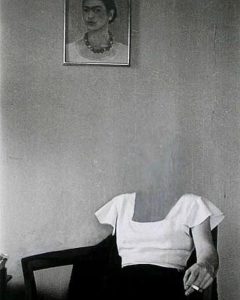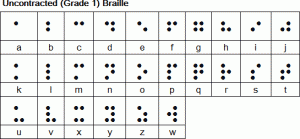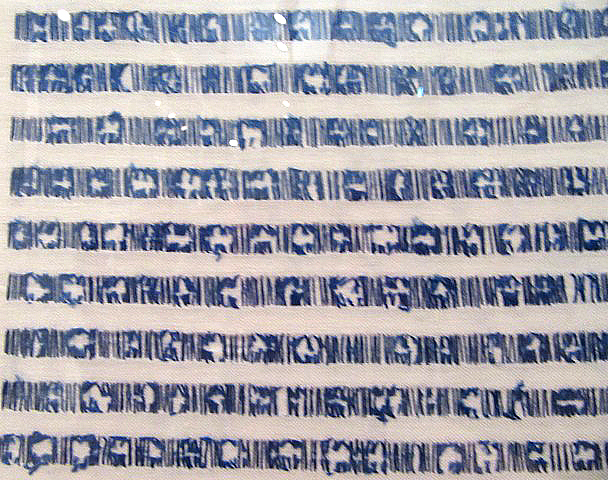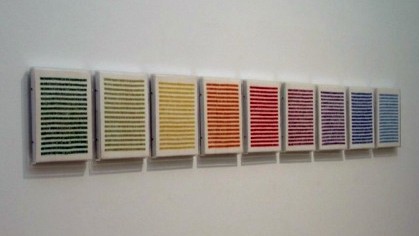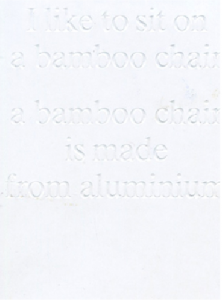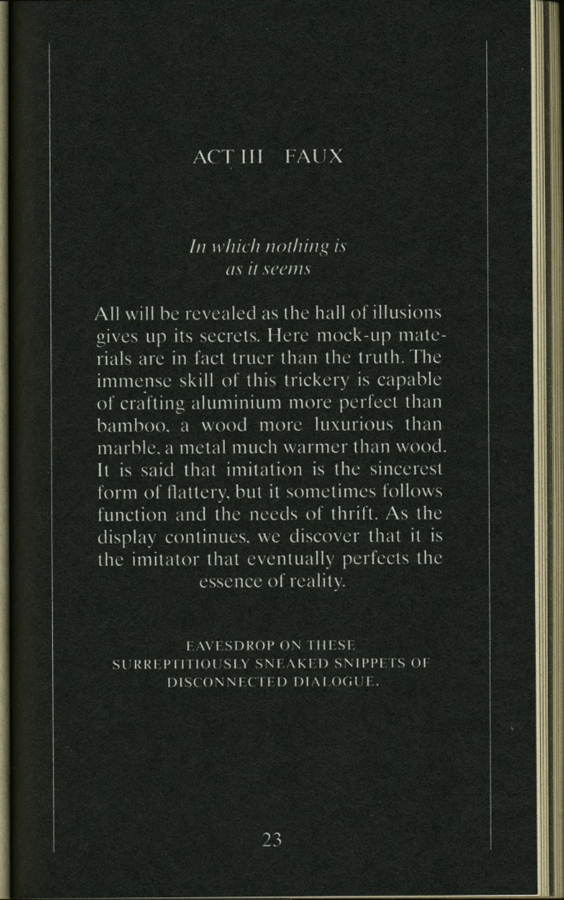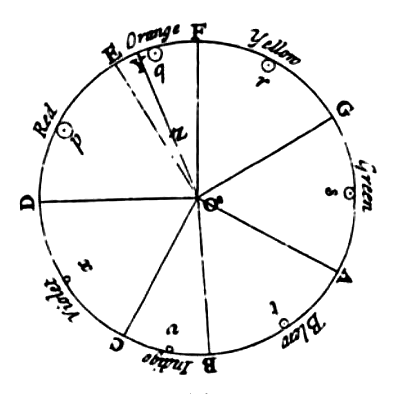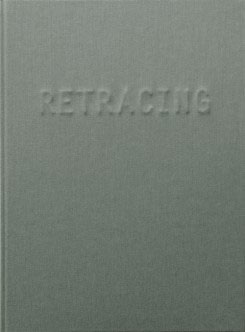
I enter the space and I know my mission.
I know that Today is my lucky day.
I’m heading up for something that interests and feels good to me, only one item is required.
It is an especially pleasing and reassuring occasion because I know what this place could do to me.
I love and hate this place.
As an example I know that I don’t know much, and this, adding a bit of curiosity, could keep me here for a couple of days.
Entering here I am well aware that words can trick, seduce, redeem or amaze people.
I remember that words are doors, that books are sleeping souls and that this open graveyard was once compared to a labyrinth, which indeed it is a sneaky way to describe a prison.
But today I’m blind from any content and this is my luck.
Thousands words laying down like disarmed soldiers, sleeping giants.
I’m blind and that’s the reason why I am wandering between bookshelves touching each spine, trying to use a different sense.
In this way I find the book, or the book shows itself to me.
Only by touching I read its title.
I open it and I feel the ink on its pages, the different kinds of paper used. It seems an attempt to remember something lost,it presents pictures in various format, it looks like dialogue between material. I still don’t know what this lost message is, after there is a text that I have not read yet. Anyway I am going to explore it now, trying to retrace it.

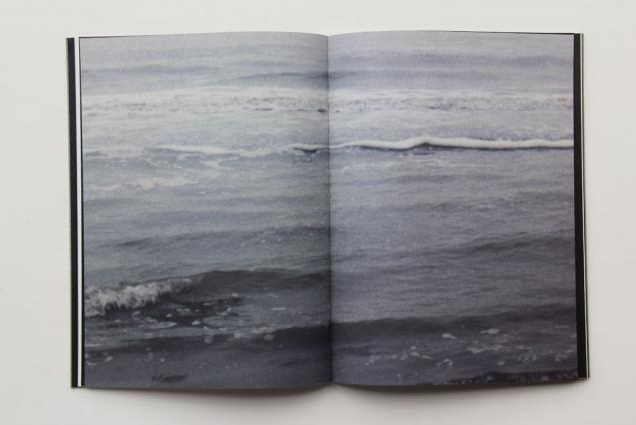
Artist Rein Jelle Terpstra,
Book Retracing
Publisher Post Editions
Design, Studio Joost Grootens
17:45 12-11-2015
I am starting my research, I flipped twice every page of the book, still haven’t read the few written pages at the end. I am not doing so because I think it will probably be a sort of description of the work, and I would rather focus on the first part.
Like when facing a magician, you don’t want to know the trick from the beginning.
As well I want to keep being blind all those words cause this is why I choose this book, my research method.
Within its covering major capitals that protrudes through the grey linen cover, I can feel a dialogue, and I want to follow to it carefully.
It seems we are facing double track, series of thick deeply back matte pages are followed by glossy, light and shining ones, it is such for all the length of the book.
I figure out that the big thick black pages depict what it must have been a slideshow projection.
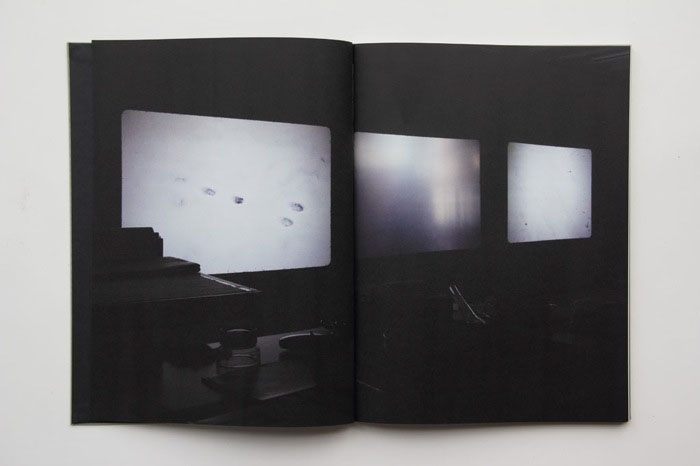
In the dark of the room you can recognize the size of 35mm colour film slides projected on a wall, in the background emerge some objects like a desk and a chair. I have no clue what this slideshow is about, the diapositives depict snowy landscapes, flowers, tables.
The photos seems unrelated and the only thing I can feel is a taste as nostalgia and loneliness.
After few pages, this dark thick and deep side crash against a bright, clean and light one.
This new part is showing also some 35mm diapositives, but this time, thanks to the properties of the paper and the print, the images are clear and easy to watch. Still they are presented as part of a slideshow, and sometimes images are cut in half, leaving a white space before or after them.

For the whole length of the books these two part keep switching, dark and light pages alternate themselves, here you can see how.
If content of the pictures seems random I notice that the photos of one section reappear in the other, the slideshow must be about these 35 mm presented in the white side. My feelings are now confused. I feel like facing a reality (each photo) and being driven from a clear to a dark side of it continuously, as if we were inside a paradox,or like facing a duality a transition.
Like going form consciousness (white and clear pages) to oblivion (dark and blurry ones),from reality to memory.
All images show familiar, personal or peculiar places. I don’t know why the author made this double track, I don’t know why these and not other photos are in it and I don’t know why in this order. I need to know more, I wish I know more.
02:21 16-11-2015
I read the end of the book, everything sounds so funny to me now.
I discover why the book was and is so special to me, why I did chose it and indeed why I was so confused by the way is designed.
As described in the internet “Retracing’ is part of a wider investigation into perception, memory, photography, and the possibility of imagelessness. Rein Jelle Terpstra is working with people who are about to lose their eyesight. He has photographed images that are valuable to them on Kodachrome slides, with the promise to describe the prints after a few years very carefully in words, in an attempt to invoke the images in their heads through language. Earlier Terpstra made a slideshow installation with multiple projectors in which the light images of ‘Retracing’ slowly blend”.
The book that I chose blindly turned out being made for blind people, and it’s content try to describe how an image can disappear.
It simulate how our memories work but it is also an the attempt to save them. In fact Rein chose to make visible something impossible to visualize, to describe the process of disappearing while at the same time reverting it. She crystallize memories in order to give them back to their owner, to change the destiny of a memory while showing us how it can and does fade.
I said it sounded so funny to me because in a cynical way I think that my choice couldn’t be more natural.
Retracing came to me because of my research method, but the real magic lay in the fact that its design has been able to translate the content of the book into a material form. The design of the book, starting from its cover, where the letters of the title are almost invisible and only “vaguely looms out at a certain incidence of light”. The cover already speak about its content starting a tautological circle, the thickness and the quality of the paper, different for different papers and its printing methods.
Every element sustains the concept behind the books giving it a physicality.
Every detail is a confirmation of the central statement and it strengthen its power.
I wish I know more about who designed the book, I know that his name is Joost Grootens, that he lives in Amsterdam and that following what internet says should look like this:

01:32 18-11-2015
I still think how nice it is that a book can speak in so many ways.
For example I have always appreciate old books, probably because you can feel that somebody (and not something) made it.
You can feel that the personal touch overcome its production, and I can wonder how much work and attention is behind every page.
In this way the page itself is becoming a medium behind the text or the information it is presenting. It feels that reading while touching such a book goes beyond its text.
22:24 19-11-2015
Today we had a meeting regarding our researches. I had more info regarding Grootens, for the entire meeting I had in my hands another book he designed, actually his own book, designed by himself for himself,
and it is GREAT.
I realize I should start a new post regarding this book but I will just say some words about “I SWEAR I USE NO ART AT ALL, 10 years, 100 books, 18788 pages of book design”, (in short ISIUNAAA).
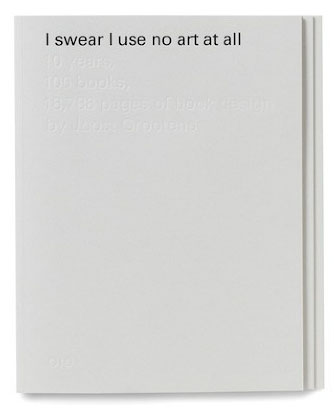
First of all, it seems to me as the most rational and efficient work-related autobiography one can person can eventually make, for what I saw so far at least. In it are described all the works Joost made in the last 10 years, first presenting various charts regarding how his projects evolved, with whom, when and how.
As well he show a timeline about how each book or project was connected with others, describing why they were made or how they started, he present a map of the different studios where he worked, which and how many different kind of paper he used, all the kinds of binding methods, typeface, pictogram, pattern, grid and colour he chose for each book.
Here I decide to post some of these schemes and charters to make my amusement understandable.
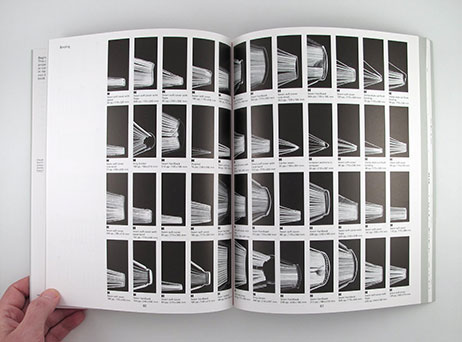
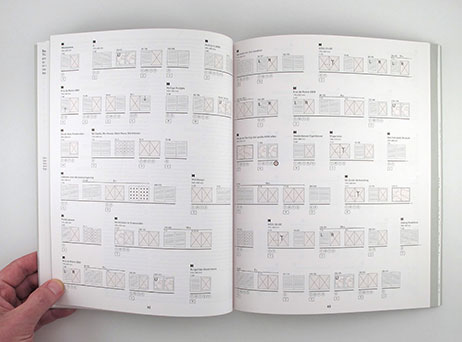
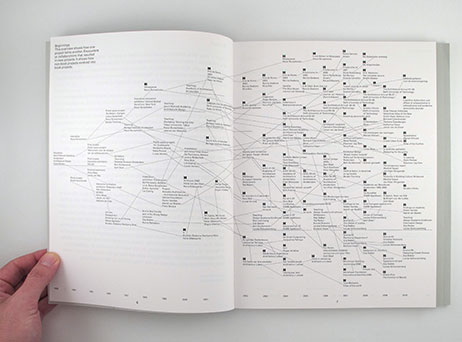
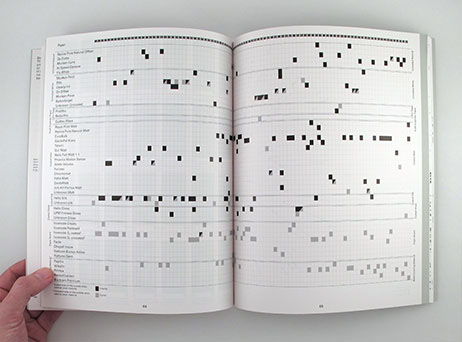
The book is a masterpiece of order and functionality, but without losing an intriguing physical effect.
As for RETRACING the book can speak for itself about itself without the use of words, intact in the last part Joost present some samples of the 18788 pages he made, but with a trick. He reverse the order of each page so where it should be written “apple” you will read “elppa”, this on order to make the reader look at the design without the possibility of reading its content.
00:35 23-11-2015
I found myself thinking a lot about ISIUNAAA,and I am amazed about the attention the author placed in his book, as for the control he has over it and the power of a systematical method. I think Grootens must love his work and in his book his passion manifests powerfully. RETRACING is a vivid example of it and ISIUNAAA is its symbol. It is like an old book, the attention in making it help to create a new channel of communication.
3:09 30-11-2015
It is more than a week that I am collecting memories about the book I saw only for one afternoon.
In the last week I went to the city looking for Grootens magical book, no one has it but I finally found it in Denmark.
It arrived yesterday and I can’t escape from it.
This is the end.
My research end with the beginning of a new one.
I had one more proof how much books are powerful, how much they can speak depending on how much attention they received while making them. I understand that an almost maniacal approach can be useful if it explores carefully the possibility to best way for express an idea and I intend to use this approach for my future researches.
It is important to remember that the focus and attention in the phisical presentation of a work is essential for increasing its power and strength. I am very glad all this happen, I am glad RETRACING pushed me to RETRACE, claiming awareness screaming beneath an almost invisible but powerful surface.
Rietveld library catalog no : ter 1
